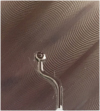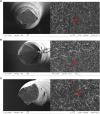1. Schilder H. Cleaning and shaping the root canal. Dent Clin North Am. 1974; 18:269–296.
2. Tsesis I, Rosenberg E, Faivishevsky V, Kfir A, Katz M, Rosen E. Prevalence and associated periodontal status of teeth with root perforation: a retrospective study of 2,002 patients' medical records. J Endod. 2010; 36:797–800.

3. Aydin B, Köse T, Calişkan MK. Effectiveness of HERO 642 versus Hedström files for removing gutta-percha fillings in curved root canals: an ex vivo study. Int Endod J. 2009; 42:1050–1056.
4. Cujé J, Bargholz C, Hülsmann M. The outcome of retained instrument removal in a specialist practice. Int Endod J. 2010; 43:545–554.

5. Wilcox LR, Roskelley C, Sutton T. The relationship of root canal enlargement to finger-spreader induced vertical root fracture. J Endod. 1997; 23:533–534.

7. Higuera O, Plotino G, Tocci L, Carrillo G, Gambarini G, Jaramillo DE. Cyclic fatigue resistance of 3 different nickel-titanium reciprocating instruments in artificial canals. J Endod. 2015; 41:913–915.

8. Al-Sudani D, Grande NM, Plotino G, Pompa G, Di Carlo S, Testarelli L, Gambarini G. Cyclic fatigue of nickel-titanium rotary instruments in a double (S-shaped) simulated curvature. J Endod. 2012; 38:987–989.

9. Johnson E, Lloyd A, Kuttler S, Namerow K. Comparison between a novel nickel-titanium alloy and 508 nitinol on the cyclic fatigue life of ProFile 25/.04 rotary instruments. J Endod. 2008; 34:1406–1409.

10. Yared G. Canal preparation using only one Ni-Ti rotary instrument: preliminary observations. Int Endod J. 2008; 41:339–344.

11. Varela-Patiño P, Ibañez-Párraga A, Rivas-Mundiña B, Cantatore G, Otero XL, Martin-Biedma B. Alternating versus continuous rotation: a comparative study of the effect on instrument life. J Endod. 2010; 36:157–159.

12. Uslu G, Özyürek T, Yılmaz K, Gündoğar M. Cyclic fatigue resistance of R-Pilot, HyFlex EDM and PathFile nickel-titanium glide path files in artificial canals with double (S-shaped) curvature. Int Endod J. 2018; 51:584–589.

13. Topçuoğlu HS, Topçuoğlu G, Kafdağ Ö, Arslan H. Cyclic fatigue resistance of new reciprocating glide path files in 45- and 60-degree curved canals. Int Endod J. 2018; 51:1053–1058.

14. Serefoglu B, Kaval ME, Micoogullari Kurt S, Çalişkan MK. Cyclic fatigue resistance of novel glide path instruments with different alloy properties and kinematics. J Endod. 2018; 44:1422–1424.

15. Keskin C, İnan U, Demiral M, Keleş A. Cyclic fatigue resistance of R-Pilot, WaveOne Gold Glider, and ProGlider glide path instruments. Clin Oral Investig. 2018; 22:3007–3012.

16. Yılmaz K, Uslu G, Özyürek T.
In vitro comparison of the cyclic fatigue resistance of HyFlex EDM, One G, and ProGlider nickel titanium glide path instruments in single and double curvature canals. Restor Dent Endod. 2017; 42:282–289.

17. Uslu G, Özyürek T, İnan U. Comparison of cyclic fatigue resistance of ProGlider and One G glide path files. J Endod. 2016; 42:1555–1558.

18. Al-Hadlaq SM. Evaluation of cyclic flexural fatigue resistance of 25/0.04 and 25/0.06 twisted file rotary nickel-titanium endodontic instruments. Aust Endod J. 2013; 39:62–65.

19. Larsen CM, Watanabe I, Glickman GN, He J. Cyclic fatigue analysis of a new generation of nickel titanium rotary instruments. J Endod. 2009; 35:401–403.

20. Neelakantan P, Reddy P, Gutmann JL. Cyclic fatigue of two different single files with varying kinematics in a simulated double-curved canal. J Investig Clin Dent. 2016; 7:272–277.

21. Duke F, Shen Y, Zhou H, Ruse ND, Wang ZJ, Hieawy A, Haapasalo M. Cyclic fatigue of profile vortex and vortex blue nickel-titanium files in single and double curvatures. J Endod. 2015; 41:1686–1690.

22. Topçuoğlu HS, Düzgün S, Aktı A, Topçuoğlu G. Laboratory comparison of cyclic fatigue resistance of WaveOne Gold, Reciproc and WaveOne files in canals with a double curvature. Int Endod J. 2017; 50:713–717.

 , where NCF is NCF of the files, rpm is revolutions of the files per minute, and duration is measured in seconds). The length of each broken end was measured with a digital meter (WT 20130 Digital Power Meter, Yokogawa Electric Corp., Tokyo, Japan). Broken surface images of 2 files from each group were examined by scanning electron microscopy (SEM) (Quanta 450, FEI, Hillsboro, OR, USA) in order to confirm that the fracture was due to cyclic fatigue.
, where NCF is NCF of the files, rpm is revolutions of the files per minute, and duration is measured in seconds). The length of each broken end was measured with a digital meter (WT 20130 Digital Power Meter, Yokogawa Electric Corp., Tokyo, Japan). Broken surface images of 2 files from each group were examined by scanning electron microscopy (SEM) (Quanta 450, FEI, Hillsboro, OR, USA) in order to confirm that the fracture was due to cyclic fatigue.




 PDF
PDF Citation
Citation Print
Print





 XML Download
XML Download